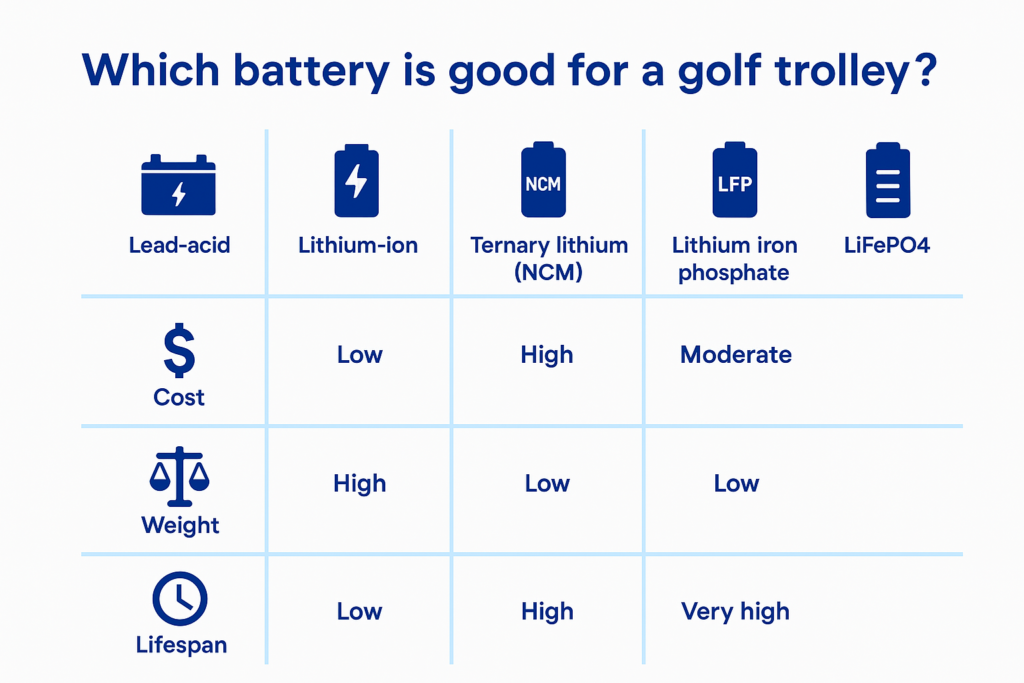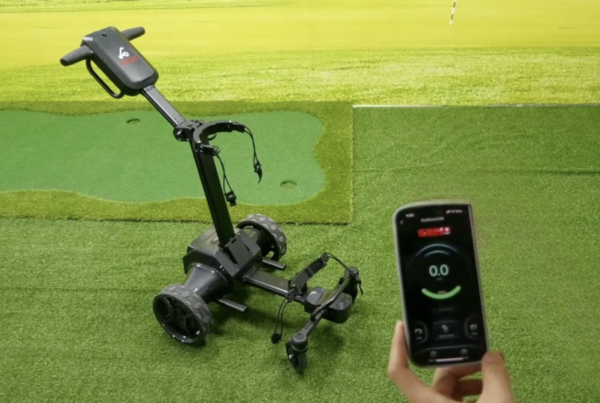Introduction:
When choosing an electric golf cart, one of the most frequent questions we hear is: which battery is good for a golf trolley?
Electric golf trolleys have evolved rapidly over the last decade—from basic push-assist models to cutting-edge “Follow Me” smart trolleys like the Icango G5. But no matter how advanced the tech, one factor plays a critical role in performance, longevity, and user experience: the battery.
Choosing the right battery can mean the difference between a smooth 36-hole day or your cart dying halfway through a round. So, which battery is good for a golf trolley? Let’s break it down from battery types to performance, and why Icango G5 chooses ternary lithium for our “Follow Me” golf trolleys.
Types of Batteries Used in Golf Trolleys
Today’s golf trolleys are powered by three main battery technologies:
1. Sealed Lead Acid (SLA)
- Cheapest option, but heaviest
- Short lifespan (150–200 cycles)
- Bulky and less energy-dense
- Common in entry-level trolleys
2. Lithium Iron Phosphate (LiFePO4)
- Lightweight and very safe
- Long life (2000+ cycles)
- Slower energy discharge
- Often used in mid-range remote control carts
3. Ternary Lithium (NCM or NCA)
- High energy density, lightweight
- Suitable for Follow Me or smart carts
- Long range and faster charging
- Lifespan of around 800–1000 cycles

Which battery is good for a golf trolley – comparison of battery types
Battery Differences and Cost Comparison
Different battery chemistries affect not just the performance but also the cost, weight, and convenience. Here’s a quick comparison:
| Battery Type | Lifespan (Cycles) | Weight (kg) | Avg. Price (USD) | Used In |
|---|---|---|---|---|
| SLA | 150–200 | 8–10 | $70–$100 | Budget/manual trolleys |
| LiFePO4 | 2000+ | 3–5 | $200–$300 | Remote control trolleys |
| Ternary Lithium | 800–1000 | 2.5–4 | $250–$400 | Smart “Follow Me” trolleys |
Summary of Key Differences:
- Weight: Ternary Lithium is the lightest, ideal for mobile carts.
- Durability: LiFePO4 lasts the longest in cycles.
- Power-to-Weight Ratio: Ternary Lithium leads.
- Cost: SLA is cheapest but also least reliable.
Check out Stewart Golf for their X10 Follow battery specs.
If you’re looking for a complete feature breakdown, check out our Smart Features Every Electric Golf Trolley Needs guide.
What Batteries Are Most Common in Remote and Follow Me Trolleys?
Electric golf trolleys fall into two key categories—remote-controlled and “Follow Me” smart carts. Each has specific power needs:
Remote-Controlled Carts
- Typically use LiFePO4 batteries
- Known for durability and steady discharge
- Less energy-demanding than radar-based trolleys
“Follow Me” Smart Golf Trolleys
- Use Ternary Lithium (NCM/NCA)
- Lightweight, quick to recharge, and energy-dense
- Ideal for intelligent systems like GPS, radar, and obstacle avoidance
These trolleys require powerful, compact batteries to maintain performance while navigating slopes and complex terrain.
Which Batteries Are Used by Leading “Follow Me” Golf Trolley Brands?
Here are some market-leading models and their battery choices:
- Stewart Golf X10 Follow – Ternary Lithium
- MOTOCADDY M7 Remote – LiFePO4
- Foresight SmartCart – Ternary Lithium
- Icaddy Smart Follow – LiFePO4 or NCM variants
- Icango G5 Follow Me – Ternary Lithium (NCM)
📌 Pattern Observation:
Most premium Follow Me golf trolleys are moving toward Ternary Lithium, thanks to its lightweight build, high energy output, and compact design.
Why Icango G5 Uses Ternary Lithium (NCM) Batteries
We make smart Follow Me electric golf caddies. At Icango, we chose NCM Ternary Lithium batteries for the G5 series. We made this choice after years of research and user feedback.
Here’s Why:
- Lightweight design keeps the trolley agile on slopes
- Stable voltage discharge supports continuous radar and motion control
- Fast charging saves time between rounds
- Good lifespan (800–1000 cycles) for long-term performance
- Compact housing allows for better design integration
User Experience First:
Our customers care about reliability, range, and portability—and NCM batteries consistently outperform other options in real-world conditions.

Ternary lithium battery in Follow Me golf trolley
Which Battery Is Good for a Golf Trolley? Our Final Thoughts
The right battery depends on your use case:
- For casual players or budget trolleys, SLA is cost-effective but limited.
- For remote control carts, LiFePO4 offers excellent stability and cycle life.
- For premium Follow Me smart trolleys, Ternary Lithium (NCM/NCA) is the top choice.
🔢 Quick Recap – Choosing the Right Battery:
- Determine your golf trolley type (manual, remote, follow).
- Match battery chemistry to power needs and budget.
- For smart functions and rugged terrain, go with ternary lithium.
- Check weight, charge time, and expected cycle life.
Conclusion: Choose Smart, Ride Farther
So, which battery is good for a golf trolley in 2025? The answer lies in balancing performance, price, and technology. At Icango, we believe that innovation starts at the core. That’s why we use NCM ternary lithium batteries for our G5 Follow Me trolley.
No matter if you are a golfer, retailer, or tech fan, picking the right battery is important. It’s not just about going further; it’s about being smarter.
For more about lithium battery chemistry in e-mobility, see Battery University.
If you’re looking for a complete feature breakdown, check out our Icango G5 Follow Me Golf Trolley guide.





